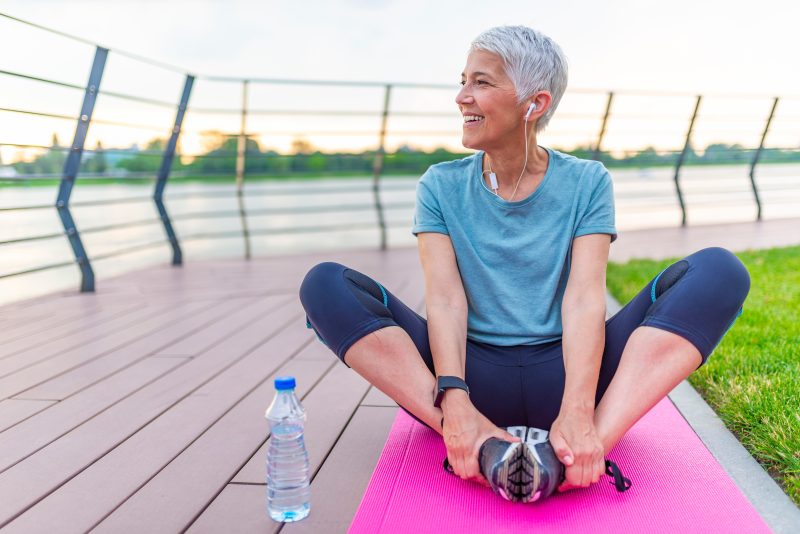PUBLISHED: 27th April 2012

I am not someone who is drawn to exercise. In my teens, I avoided exercise and didn’t take care of my body. And yet, at age 49 I find myself in the best physical shape of my life because I have learned to incorporate exercise into my routine. I have read many studies demonstrating the health benefits of exercise for cancer (and other diseases) prevention, improved quality of life, and increased chances of survival. And with research suggesting that BRCA mutation carriers may have additional cardiovascular risks, there is more reason than ever to stay active. Still, fitness doesn’t come naturally for many people, myself included.
I’m not an exercise guru, and this is not professional advice, but I would like to share techniques and tips that I have learned over the years to maximize my overall fitness and lower my chances of derailing my exercise program. In keeping with our “13 things” campaign, below are 13 tips for incorporating fitness into your life.
1. Avoid injury. Nothing can sideline a person from exercise more quickly than an injury. Although it is impossible to eliminate all potential for injury, you can take steps to lower your risk:
- Warm up for several minutes before you begin your routine.
- Cool down after you work out and before you rest.
- Include flexibility and strength training as part of your program.
- Vary your exercise routine. Repetitive motions can increase the risk of certain injuries.
- Learn and practice good technique. A personal trainer or coach can demonstrate techniques that lower your risk for injury.
- Follow the next two tips.
2. Invest in the right equipment. Exercise gear has improved over the years. Tennis racquets are lighter and the head size has changed. Roller blades are more comfortable and faster. When I was a kid, we called all athletic shoes “tennis shoes.” These days athletic shoes are very specialized by sport. I learned that the hard way when I pulled my calf muscle while playing tennis in running shoes. Having the right shoes and equipment can make a difference. If you haul out your bike that has been sitting in your garage for five years, be sure to get it tuned up to check the brakes, tires, and gears before you ride. And don’t forget to invest in protective gear: helmets, knee, wrist, and elbow pads can minimize the damage from a collision or fall.
3. Set realistic goals. Don’t overdo it or try to make up for 10 sedentary years in one workout. Don’t expect to be able to run or lift weights like you did in college, at least not off the bat. Not only can that approach set you up for injury, it can also be discouraging if you’re not used to exercise.
4. Be patient for progress. Sometimes small changes over time lead to big improvements. If you’re going in the right direction over time, it’s okay if your progress is slow. Monitoring your progress over time is the best way to see long-term benefits. Nike and others make free or inexpensive fitness tracking apps such as Nike + GPS which allows you to track running progress.
5. Pursue physical activities you love. There are so many ways to exercise: classes like spinning, zumba, yoga, or step; competitive sports, workout programs. Try to find two or three activities you love. Incorporate cardiovascular, strength and flexibility activities into your routine.
6. Dress for comfort and protection. If you’re like me, it is easy to become distracted when you begin exercising. Sometimes even the smallest thing, such as uncomfortable shorts, can provide an excuse to stop. Dressing comfortably helps to remove one distraction from physical activity. If you like to exercise outdoors during the day, wear a strong sunscreen (at least SPF 30), protective clothing, and a hat. Wear reflective gear if you exercise outside after dark.
7. Plan for and fit exercise into your day. The best way to assure that you work out is to plan for it and schedule it into your calendar. If you wait until the end of the day to work out, you may be too tired or run out of time to exercise.
8. Surround yourself with a positive and encouraging support system. Sharing fitness goals with someone will encourage you to exercise and stay motivated; you can help each other stay positive and achieve your goals. But beware, sometimes working out with someone else can backfire if your partner doesn’t share your motivation, goals, or level of fitness. Hiring a personal trainer (if your budget can accommodate it) can be a great way to maximize your workout, maintain motivation and stay accountable for remaining on track. Some cities have local clubs where enthusiasts for a specific activity can meet, workout and train together.
9. Silence the inner saboteur. When I’m getting ready to exercise, sometimes my subconscious sends negative messages. I’m not sure why that is, but they are intrusive and sometimes persuasive—this the same voice that tells me it’s okay to eat a pint of ice cream or finish off the Halloween candy. One motivational speaker at a fitness program I attended labeled these voices “monkey chatter.” I have found that occupying my mind with music or positive messaging silences this internal voice. Be aware of these messages and prepare yourself with rebuttals about the benefits of exercise if they pop up.
10. Set your own benchmarks. Avoid comparing your progress with others. Everyone has their own goals and pace; yours needs to be one that is comfortable for you. Trying to emulate fitness role models can be motivating, especially individuals who have achieved what you hope to accomplish. But be careful not to use their example to beat yourself up or to make yourself feel bad if you have not yet measured up to their accomplishments.
11. Create a positive environment. Try to exercise in different environments to determine what works best for you. Do you enjoy a class setting where other people can cheerlead and keep your energy elevated? If you like to exercise to music, create a playlist of the tunes that inspire you or make you want to move. If you like running, biking or hiking outdoors, find trails or paths that keep you inspired. If you prefer indoor activities, consider putting your treadmill in front of your TV (many TVs now offer closed captioning if the equipment makes it too loud to hear).
12. Expect and prepare for plateaus and setbacks. It’s not always reasonable to keep pushing and increasing your activity level daily. Some days just getting out and taking a short walk or maintaining the progress you made the week before is enough. You may have days when exercise comes easily, followed by others when it’s hard to motivate yourself to take that first step.
Once you reach your first fitness goal, it can be healthy to maintain that level for a while before pushing to your next milestone. Remember, over the long term it’s natural to have plateaus and setbacks. Try not to beat yourself up for the occasional day off.
13. Never punish eating with exercise. The goal is to make exercise rewarding and fun. Using exercise as a punishment for overeating will develop a negative association between the two. Try to approach your exercise as “me time,” something nice that you do for yourself. Over time you may come to appreciate exercise as a gift you give to yourself
Since January 2012, I have progressed from being able to run a mile to now running seven miles without stopping. My goal by next year is to complete a half-marathon before I turn 50 in April 2013 (“half marathon by half-century"). I would love to hear your fitness goals and feedback. Please share any tips and let me know if the suggestions above work for you.
POSTED IN: Health And Fitness
TAGS: BRCA , Breast Cancer , Cancer Prevention , Hereditary Cancer Research , Ovarian Cancer , Genetic Testing , BRCA1 , BRCA2 , Previvor , Survivor , Exercise , Fitness
13 Comments
April 30, 2012
As one who struggles with exercise for many reasons, I really appreciate these tips. Thanks for the realistic and helpful suggestions.
Nancy's Point (@NancysPoint)
Reply
May 1, 2012
Great tips! I just wanted to add on to your #9 and that is never say something to yourself in your head that you wouldn't say to your best friend next to you (in class, running, at the gym, etc.) Also, using positive self talk helps. If you walk around saying, "I hate to exercise" then you will. If you say, "I love to exercise" you trick your mind into believing it and eventually it will happen. Can you tell I love to exercise already!?!? I do appreciate the tips though :o)
Erin
Reply
October 26, 2023
"I love how your blog inspires me to stay committed to my fitness journey! Your tips are always so practical and motivating. Keep up the great work, and thanks for being a source of inspiration!"
Gurmeet Nain
Reply
March 26, 2021
All the points are absolutely amazing if you want to get success in the fitness industry. I just want to add training with the right people getting motivated from the right ones makes u even better. Many people just for showoff try to lift the heavy weight which can destroy you and your goals, so being around with the good ones is just best.
SP fitness house
Reply
October 17, 2022
hey, wonderful tips, We all struggle with the motivation to work out. It’s not easy to stay inspired to hit the gym or keep up with a daily workout routine. Comfort zones are not the best place for true greatness. thank you for your great tips....
Lisa George
Reply
April 28, 2021
Thank you for spreading your thoughts. I truly appreciate your efforts and I am waiting for your next write-ups.
Olivia Hartley
Reply
May 29, 2021
Just came here to check out this blog. Turn out to be a piece of really amazing information I find here. I think everyone in the world should take fitness seriously. Glad to visit this page.
PRATIK NIPANE
Reply
July 6, 2021
Fitness trackers can motivate you to up your movement and steps for the day!
Ashley Sison
Reply
September 11, 2021
Thanks for sharing information article.
Gary
Reply
January 27, 2023
Amazing information shared by the author in the post . Love to read your post
Elliott Brown
Reply
October 18, 2021
Amazing blog and best selection of words totally informative for every one thanks for sharing!
John Paul
Reply
November 20, 2024
Great tips! These are super practical and make incorporating fitness into daily life so much easier. Thanks for sharing!
vallapu
Reply
March 6, 2025
Helpful tips to stay fit
Energy Fitness
Reply
